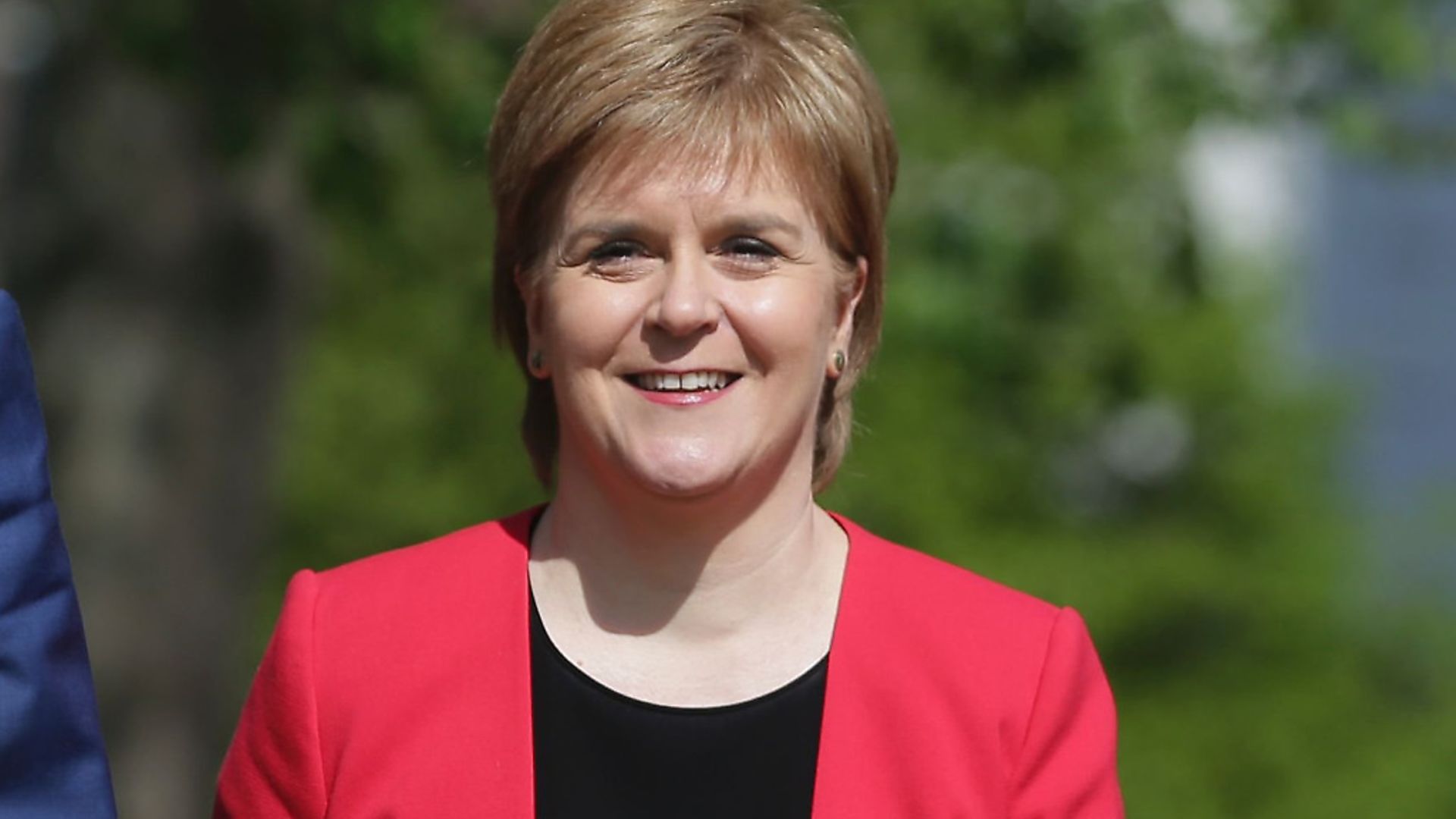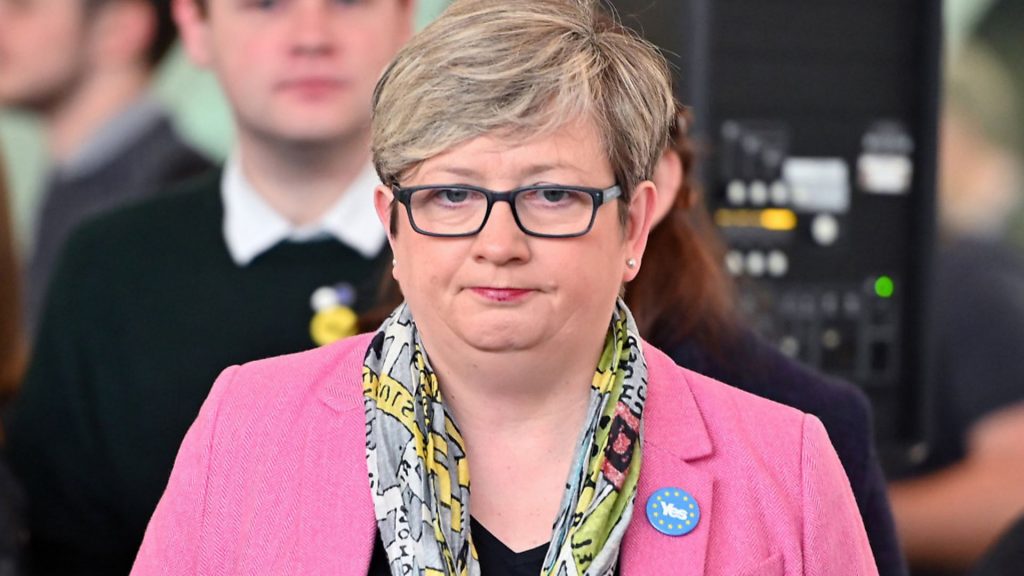
Scotland’s first minister has seemed to be among Britain’s most secure and formidable politicians. But, says MAURICE SMITH, the SNP leader appears to be listing.

Politics can sometimes be all about appearances. On the night the UK left the EU at the end of January, SNP leader Nicola Sturgeon suggested that Europe had ‘left a light on’ for Scotland to return to the fold.
As evidence she retweeted a picture of the words ‘Scotland’ and ‘Europe’ combined with a heart and projected across the side of the European Commission building in Brussels. The image of Europe pining for Scotland on the very day of Brexit appealed to many. But its lustre faded when it emerged that in fact the projection had been staged by an Edinburgh firm, and paid for by the SNP. Worse, apparently the EC hadn’t granted permission for the stunt.
Sturgeon’s party continues to dominate Scottish politics. But it is less sure footed than before. And recent events betray a deepening split over the party’s core strategy, independence.
The fissures can be seen, most evidently, in the battle that has broken out between two party heavyweights vying for the SNP nomination for the same seat in next year’s Scottish parliamentary elections.
The seat in question is Edinburgh Central. Since 2016 it has been held by Ruth Davidson, who announced abruptly last summer that she was resigning as Scottish Conservative leader, and later that she would be leaving the Scottish parliament altogether.
Without the talismanic Davidson, the Tories will find it hard to retain the seat. She took it in 2016, with a majority of just 610 from the SNP who are clear favourites to take it back at the next election.
The favourite for the slot had been Angus Robertson, previously the party’s Westminster leader until losing his seat in 2017, who set up a lobbying company while courting the Edinburgh Central constituency during recent months.
His return to party politics was seen as a formality. An ally of first minister and party leader Nicola Sturgeon, he has been seen as a potential successor.
So far, so well planned. Until last month, when Edinburgh South West MP Joanna Cherry surprised insiders by declaring that she will seek the Edinburgh Central nomination, in competition with Robertson. There has followed a not-so-subtle war of words, played out increasingly on social media, to the dismay of party leaders and activists.
The coming nomination battle is about more than the right to fly the SNP flag in an important constituency that is eminently winnable for the party. For Robertson and Cherry are also indulging in a proxy war with further-reaching consequences: these two are expected to be leadership candidates whenever Sturgeon decides to move on.
The idea of a Sturgeon resignation seems far-fetched to many party loyalists. To observers of Scottish politics it may seem odd, given that the first minister’s handling of major issues such as Brexit has seemed sure and intelligent, especially compared to several leading politicians at Westminster. Her party has run the Scottish parliament for 13 years and has every chance of winning again in 2021.
But the SNP stands accused of failing to apply its own lofty ideals to the nitty-gritty of managing key services in Scotland such as health and education. Sturgeon’s administration – her cabinet, special advisers, spin doctors and MSPs – is tightly controlled.
The party machine is headed by SNP chief executive, Peter Murrell, who also happens to be the first minister’s husband. As one former insider remarks: ‘There isn’t much goes on in the party that they don’t know about in that household.’ In that environment of top-down control, it is more difficult to distance the first minister from various negative stories.
Opposition parties struggled to make the ‘incompetence’ label stick, until recently. But 13 years in power – three Holyrood election victories and a large proportion of Westminster seats retained – may have led to complacency, even hubris. Long-surviving governments often get themselves into fankles, leaving themselves open to charges of incompetence and graft. Individuals become embroiled in scandal. And, as in the case of Edinburgh Central, internal spats spill into the public domain.
In an anonymous Holyrood committee room, a true scandal is being examined by an all-party group of MSPs whose brief is the ‘rural economy and connectivity’. Ostensibly, they are looking into the way new ferries are procured for the Scottish islands. In reality, Scottish Tory committee chairman Edward Mountain and his colleagues are listening to shocking allegations of incompetence, financial loss and corporate failure, concerning a £97 million contract to build two vessels for operation by Scotland’s major ferry operator, Caledonian MacBrayne – universally known as CalMac.
Remember that figure of £97m. It has taken on a relevance on several fronts, whether addressed by Scottish ministers, the publicly-owned agency that awarded the contract in 2015, or Ferguson Marine, the company that won the deal and went bust after failing to deliver, four years later.
Have your say
Send your letters for publication to The New European by emailing letters@theneweuropean.co.uk and pick up an edition each Thursday for more comment and analysis. Find your nearest stockist here or subscribe to a print or digital edition for just £13. You can also join our readers' Facebook group to keep the discussion and debate going with thousands of fellow pro-Europeans.
The two ferries, which should now be servicing routes to Arran and Lewis, remain at the Ferguson yard, in Port Glasgow. The MV Glen Sannox, sits in the Lower Clyde alongside the yard, having been launched to great fanfare by first minister Sturgeon more than two years ago. The inquiry heard that the ship is far from finished. It has been lying in the water so long that it requires several million pounds’ worth of repainting and repairs.
The steel skeleton of the second vessel, known as Hull 82, sits on a slipway. Tim Hair, a ‘turnaround specialist’ brought in by ministers to supervise the yard, estimates that the total completion cost will be around £200m – more than double the original estimate. Some witnesses told MSPs it would be cheaper to scrap both and start again.
The yard was nationalised by the Scottish government in December. Apart from the £83m that had been paid out to Ferguson, ministers had sanctioned two loans totalling £45m to the company to aid its cash-flow while it battled with its client, state-owned Caledonian Maritime Assets Limited (CMAL), over responsibility for design changes and lengthy delays.
Ferguson, the last commercial shipyard on the Lower Clyde, had earlier entered administration immediately before the independence referendum in September 2014. Sturgeon’s predecessor, Alex Salmond – whose trial on a series of alleged sexual offences began this week – enthusiastically supported the emergence of Clyde Blowers – led by Scotland’s wealthiest entrepreneur, Jim McColl – as a corporate saviour. McColl upgraded the ageing yard, recruited more staff, and was awarded the contract for two ‘dual fuel’ ferries in 2015. It turned out recently that his bid was the most expensive of several received.
McColl, who serves on the Scottish government’s economic advisory council, told the Holyrood committee last month that the first minister announced the £97m deal before negotiations had been completed. Her advisers were allegedly keen to get the news out because then-chancellor George Osborne was in Glasgow to announce a defence contract for another yard on the Upper Clyde.
McColl’s management team spent more than three years at loggerheads with CMAL. The two sides were barely on speaking terms. Ministers were asked to intervene, but failed. CMAL insists that Ferguson was entirely to blame for the delays and overspend. McColl questions why CMAL – which insisted on numerous design changes after the contract award – should even exist.
CMAL was created by Holyrood as a means of addressing European procurement rules. CalMac is 100% state-owned, and has served the Scottish islands for generations. When there was pressure for new contracts to be subjected to competition, the company’s assets – ships and dock facilities – were moved into the new company, CMAL. It manages the fleet while CalMac operates the ferry services.
Only Orkney and Shetland are serviced by a different ferry operator. CalMac operates all but one of the ferry services from Lewis to Arran. CMAL owns more than 30 ferries.
By December, the SNP’s previously close relationship with McColl had ruptured completely. Finance minister Derek MacKay heaped the blame for the scandal wholly on McColl’s company, in a parliamentary statement.
MacKay resigned abruptly after a tabloid newspaper revealed that he had sent more than 200 texts to a 16-year-old boy. His budget was delivered by Kate Forbes, a 29-year-old junior minister – since promoted to finance secretary. MacKay had been a rising star in the nationalist firmament, thought by many to be Sturgeon’s favoured successor, before his ignominious fall.
These various travails come at a time when the nationalist movement is divided on the tactical approach to Scottish independence. Ostensibly, Sturgeon wants prime minister Boris Johnson to sanction a new Scottish referendum this year. Reality dictates that the May 2021 election is more likely to be treated as an ‘independence poll’, and if the SNP remains the biggest party the referendum drumbeat will become louder.
A significant proportion of activists think Sturgeon is too cautious. Opinion polls are showing an increase in support for independence (roughly 50%, up from the 45% achieved in 2014). Leading figures such as Cherry – a QC who played a part in various legal attempts to frustrate Brexit last year; and Kenny MacAskill, a former justice secretary who recently returned to active politics as an MP – are more closely aligned to the Salmond style than to that of Sturgeon. They want a harder line than the more ‘gradualist’ Sturgeon seems to favour.
The SNP may be indulging itself simply as a result of complacency. Despite the apparent strains, it is likely to remain the largest party in Holyrood. Davidson’s departure has not helped the Conservatives, who appear stuck as the ‘pro-Union’ party in Scotland, with little to offer in terms of policy. New leader Jackson Carlaw is uncomfortable defending Brexit and the actions of a Johnson government in Westminster.
Scottish Labour remains in a mess. Morale may improve once the current UK leadership contest is over, but the party has still failed to reconcile its position on Scotland’s constitutional future. It has yet to demonstrate that it might push to Tories firmly into third place next May.
But the opposition parties are pressing the SNP for its handling of key services, arguing that the party is more interested in pursuing independence than in effective government.
In late 2014, having taken over from Salmond unopposed and with party membership soaring, Nicola Sturgeon was the star attraction at a packed supporters’ rally in the SEC Hydro, a 12,000 capacity venue more used to hosting Beyoncé, Lady Gaga or Kylie Minogue.
She has led her party through a succession of election campaigns, and generally triumphed. Her handling of the Brexit aftermath was generally admired. Now there are signs that her iron grip on the party may be slipping. Senior members of her party are dissenting on party strategy. Two leading figures are engaging in a very public selection battle in Edinburgh Central. Several leading MSPs, most of them Sturgeon allies, have indicated that they will stand down from parliament next May.
There is ill-concealed speculation about leadership succession. For all her apparent sure-footedness, Nicola Sturgeon may be gone from her role before achieving Scottish independence, or even before persuading 10 Downing Street that there should be another poll at all.









